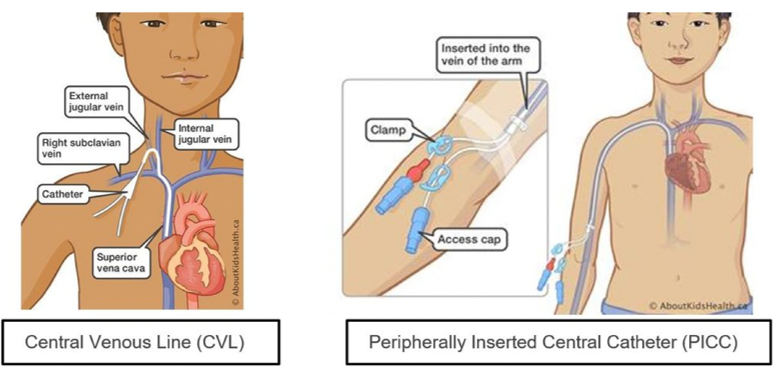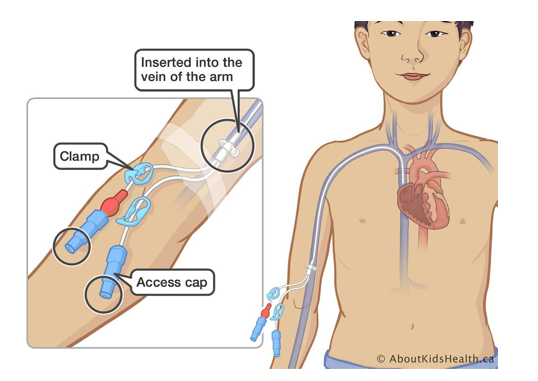ALERT: How to prevent infection when performing central venous access device (CVAD) dressing changes?
Connected Care Quick Hits are up to date and evidence based recommendations for the care of children with medical complexity & technology dependence, from hospital to home.
ALERT: How to prevent infection when performing central venous access device (CVAD) dressing changes?
SITUATION:
This QuickHit was informed by Connected Care safety reports that have highlighted inconsistent practices when performing CVAD dressing changes in home and community.
BACKGROUND:
Many children with medical complexity rely on CVADs in home and community care for long-term intravenous therapy including medication administration, parenteral nutrition, dialysis, hydration, and blood sampling. Types of CVADs include central venous lines (CVL) and peripherally inserted central catheters (PICC).
The place where the CVAD leaves the skin is called the exit site. This site is covered with a dressing that protects it from bacteria and helps prevent Central Line Associated Blood Stream Infections (CLABSI). The dressing is changed once per week or more often if it becomes damp, loosened or visibly soiled. Maintaining aseptic non-touch technique while performing a CVAD dressing change helps prevent infections at the site and into the blood stream.
ASSESSMENT:
The aseptic non-touch technique (ANTT) is a technique used to prevent infection when accessing CVADs and during dressing and cap changes. There are six core principles that help promote ANTT including:
Handwashing
Correct glove use
Key part and key site protection
Aseptic field management
Key part and key site disinfection
Key parts are parts of the equipment that come in contact with key sites, liquid infusions and/or another key part connected to the child's device. Examples are outlined in the image below and may include chlorhexidine swabsticks and dressings.
Key sites are any site where bacteria can enter the child's body. Examples are outlined in the image below and include the CVAD exit site and the open end of the CVAD (under the cap).
RECOMMENDATION:
Connected Care recommends the following best practices to maintain ANTT when performing CVAD dressing changes:
Assess the exit site and surrounding skin daily and during dressing changes for signs of infection (e.g., swelling, redness, irritation, drainage) and skin reactions. If you notice these signs, inform the child’s healthcare team immediately.
Use an appropriate cleaning solution and dressing as per the child’s care plan and home care orders.
Cleaning solutions include 2% chlorhexidine gluconate with ≥70% isopropyl alcohol or 10% povidone-iodine (also called Betadine).
Dressings include Tegaderm™ and IV 3000. Some children may have other types of dressings (e.g., gauze and tape or hydrocolloid) based on their specific needs.
For cleaning solutions to be effective on the skin and CVAD, use the following techniques:
Scrub the skin for 30 seconds with friction using a back-and-forth motion (as demonstrated in the first image).
Clean the line for 30 seconds with friction only outwards from the insertion site with two swabsticks (as demonstrated in the second image).
After cleaning the skin and CVAD, allow it to air dry for at least two minutes. Note that chlorhexidine may cause some redness if a dressing is placed on the skin before it has completely dried.
Ensure that the CVAD is secured to prevent accidental dislodgement during and after the dressing change. The Connected Care Quick Hit reviews methods of securing CVADs.
Engage family caregivers in performing routine CVAD care when appropriate (e.g., assessing the site and supporting as the 'second person' during dressing changes).
Review the AboutKidsHealth article and video that outlines and reviews the required supplies and step-by-step procedure for CVAD dressing changes.
















